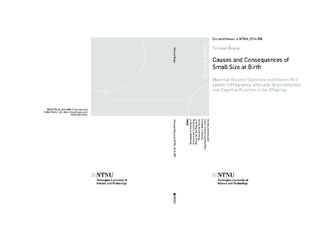| dc.contributor.advisor | Risnes, Kari R. | |
| dc.contributor.advisor | Jacobsen, Geir W. | |
| dc.contributor.advisor | Martinussen, Marit P. | |
| dc.contributor.author | Rogne, Tormod | |
| dc.date.accessioned | 2017-01-31T09:53:23Z | |
| dc.date.available | 2017-01-31T09:53:23Z | |
| dc.date.issued | 2016 | |
| dc.identifier.isbn | 978-82-326-2061-6 | |
| dc.identifier.issn | 1503-8181 | |
| dc.identifier.uri | http://hdl.handle.net/11250/2429010 | |
| dc.description.abstract | Small size at birth may be caused by restricted fetal growth or preterm birth. Each year, preterm birth and low birth weight (LBW) cause roughly half of the 2.9 million neonatal deaths globally. Additionally, small birth size has been associated with long-term outcomes such as all-cause mortality and reduced cognitive function. But when is a newborn too small? Some newborns may be physiologically small (e.g. small parents), while others are born small due to a pathological process. The latter is often referred to as fetal growth restriction (FGR). The aim of this thesis was to explore some potential causes and consequences of small birth size. We studied two potential causes of small birth size: maternal glucose tolerance and vitamin B12 (B12) levels in pregnancy. We also studied the association between fetal growth pattern and offspring cognitive function and regional brain volumes.
The first paper in this thesis was based on a large, long-term follow-up study in Scandinavia. The population was enriched with women at an increased risk of giving birth to a child with LBW. Ultrasound measurements were used to estimate fetal growth in the second and third trimesters, and an oral glucose tolerance test was performed in the third trimester. The difference between the two-hour and fasting blood glucose values was labeled delta (Δ) glucose. A total of 855 women were included in the study. We found that the most glucose tolerant women, identified by a low Δ glucose, were associated with an increased risk of carrying fetuses with suboptimal growth. These women also gave birth to thinner newborns, but of similar weight, compared with the other women.
Offspring of the women followed in the Scandinavian study were followed after birth. Cognitive function was assessed at five and nine years of age, and regional brain volumes were estimated at age 15 years. The second paper included 83 children born small-for-gestationalage (SGA; birth weight <10th percentile) at term and 105 non-SGA children. Based on serial ultrasound measurements, 13 children in the SGA-group were classified as FGR (SGA-FGR) and 36 were classified as non-FGR (SGA non-FGR). We found that children born SGA due to FGR (SGA-FGR) – but not those born constitutionally small (SGA non-FGR) – had impaired performance intelligence quotient scores and smaller thalamic and cerebellar white matter volumes compared with controls.
The last paper in this thesis is a systematic review where we evaluated the association between maternal vitamin B12 blood levels in pregnancy and newborn birth weight and length of gestation. Eligible studies provided individual patient data (IPD), and when IPD could not be provided, relevant estimates from individual studies were included in the analyses. Twentytwo eligible studies were identified, of which 18 were included in the meta-analysis (11,216 pregnancies; 94% of all eligible pregnancies). B12-deficiency in pregnancy was associated with an increased risk of preterm birth and LBW, but not SGA. The increased risk of preterm birth among B12-deficient women was similar in high-income countries and low- and middleincome countries.
This thesis suggests that pregnant women who have a high glucose tolerance may have an increased risk for carrying fetuses with suboptimal growth. Vitamin B12, however, seems to be associated with the length of gestation, but not fetal growth. The risk of reduced cognitive function and smaller regional brain volumes in childhood and adolescence seems to be higher among children born small due to restricted fetal growth than in other children born small. | nb_NO |
| dc.language.iso | eng | nb_NO |
| dc.publisher | NTNU | nb_NO |
| dc.relation.ispartofseries | Doctoral theses at NTNU;2016:358 | |
| dc.relation.haspart | Paper 1: Rogne, Tormod; Jacobsen, Geir Wenberg.
Association between low blood glucose increase during glucose tolerance tests in pregnancy and impaired fetal growth. Acta Obstetricia et Gynecologica Scandinavica 2014 ;Volum 93.(11) s. 1160-1169
http://dx.doi.org/10.1111/aogs.12365 | |
| dc.relation.haspart | Paper 2:
Rogne, Tormod; Engstrøm, Andreas Aass; Jacobsen, Geir Wenberg; Skranes, Jon Sverre; Østgård, Heidi Furre; Martinussen, Marit.
Fetal growth, cognitive function, and brain volumes in childhood and adolescence. Obstetrics and Gynecology 2015 ;Volum 125.(3) s. 673-682
Is not included due to copyright available at
http://d.doi.org/10.1097/AOG.0000000000000694 | |
| dc.relation.haspart | Paper 3:
Rogne T, Tielemans MJ, Chong MFF, Yajnik CS, Krishnaveni GV, Poston L,
Jaddoe VWV, Steegers EAP, Joshi S, Chong YS, Godfrey KM, Yap FKP,
Yahyaoui R, Thomas T, Hay G, Hogeveen M, Demir A, Saravanan P, Skovlund
E, Martinussen MP, Jacobsen GW, Franco OH, Bracken MB, Risnes KR.
Maternal vitamin B12 in pregnancy and risk of preterm birth and
low birth weight: A systematic review and individual participant
data meta-analysis. -
This article has been accepted for publication in American Journal of Epidemiology Published by Oxford University Press. Final version http://dx.doi.org/10.1093/aje/kww212 | |
| dc.title | Causes and Consequences of Small Size at Birth: Maternal Glucose Tolerance and Vitamin B12 Levels in Pregnancy, and Later Brain Volumes and Cognitive Function in the Offspring | nb_NO |
| dc.type | Doctoral thesis | nb_NO |
| dc.subject.nsi | VDP::Medical disciplines: 700 | nb_NO |

